Sensitization of Ti3+ Persistent Luminescent Lifetime-Based Thermometer by Ln3+ Co-Doping
IF 3.3
3区 化学
Q2 CHEMISTRY, PHYSICAL
引用次数: 0
Abstract
Co-doping of phosphors to induce energy transfers is a recognized approach to sensitize lifetime-based luminescent thermometers. However, introducing an additional depopulation channel is usually associated with a significant shortening of lifetime over the entire temperature range, which hinders the reliability of the temperature readout with respect to unco-doped counterparts. In this work, I analyzed the influence of the co-doping of lanthanide (Ln3+) ions on the thermometric performance of the LaAlO3: 10% Ti3+ phosphor, in which the average lifetime of the 2E excited state reaches almost 30 ms at room temperature. To optimize the sensitization strategy, I discuss the role of Ti3+ → Ln3+ and Ln3+ → Ti3+ energy transfers in the thermal evolution of Ti3+ lifetimes, where Ln3+ = Pr3+, Nd3+, Eu3+, Dy3+, Ho3+, Er3+, Tm3+, and Yb3+. The next step is the verification of the effect of the concentration of Tm3+ and Pr3+ ions as co-dopants on thermal quenching. The research allowed improvement of the relative sensitivity of the luminescent thermometer by more than 250%, exceeding 5% K–1.

求助全文
约1分钟内获得全文
求助全文
来源期刊

The Journal of Physical Chemistry C
化学-材料科学:综合
CiteScore
6.50
自引率
8.10%
发文量
2047
审稿时长
1.8 months
期刊介绍:
The Journal of Physical Chemistry A/B/C is devoted to reporting new and original experimental and theoretical basic research of interest to physical chemists, biophysical chemists, and chemical physicists.
 求助内容:
求助内容: 应助结果提醒方式:
应助结果提醒方式:


